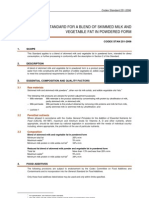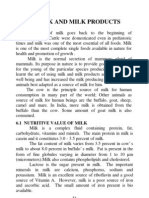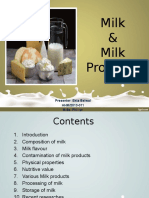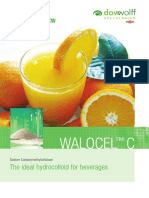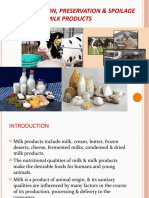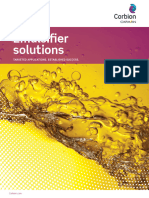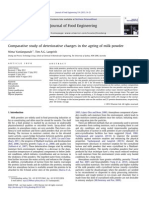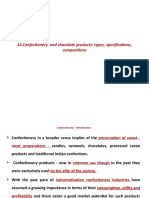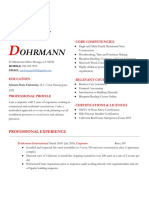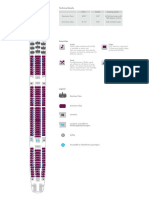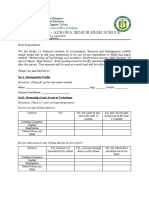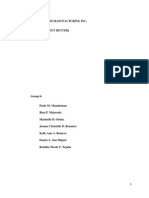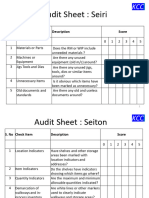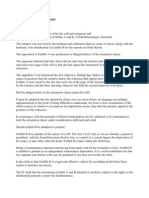CXS 282e
CXS 282e
Uploaded by
Zac HernándezCopyright:
Available Formats
CXS 282e
CXS 282e
Uploaded by
Zac HernándezOriginal Title
Copyright
Available Formats
Share this document
Did you find this document useful?
Is this content inappropriate?
Copyright:
Available Formats
CXS 282e
CXS 282e
Uploaded by
Zac HernándezCopyright:
Available Formats
CODEX STANDARD FOR SWEETENED CONDENSED MILKS
CODEX STAN 282-1971
1. SCOPE
This Standard applies to sweetened condensed milks, intended for direct consumption or further processing, in conformity with the description in Section 2 of this Standard.
2. DESCRIPTION
Sweetened condensed milks are milk products which can be obtained by the partial removal of water from milk with the addition of sugar, or by any other process which leads to a product of the same composition and characteristics. The fat and/or protein content of the milk may have been adjusted, only to comply with the compositional requirements in Section 3 of this Standard, by the addition and/or withdrawal of milk constituents in such a way as not to alter the whey protein to casein ratio of the milk being adjusted.
3. ESSENTIAL COMPOSITION and QUALITY FACTORS
3.1 Raw materials
Milk and milk powder1, cream and cream powders1, milkfat products1. The following milk products are allowed for protein adjustment purposes: Milk retentate Milk retentate is the product obtained by concentrating milk protein by ultrafiltration of milk, partly skimmed milk, or skimmed milk; Milk permeate Milk permeate is the product obtained by removing milk proteins and milkfat from milk, partly skimmed milk, or skimmed milk by ultrafiltration; and (Also for seeding purposes) Lactose1
3.2 Permitted ingredients
Potable water Sugar Sodium chloride.
In this product, sugar is generally considered to be sucrose, but a combination of sucrose with other sugars, consistent with Good Manufacturing Practice, may be used.
See Standard for Sugars (CODEX STAN 212-1999).
Formerly CODEX STAN A-4-1971. Adopted in 1971. Revision 1999. Amendment 2010.
milk and milk products (2nd Edition)
3.3 Composition
Sweetened condensed milk Minimum milkfat Minimum milk solids** Minimum milk protein in milk solids-not-fat** Sweetened condensed skimmed milk Maximum milkfat Minimum milk solids** Minimum milk protein in milk solids-not-fat** Sweetened condensed partly skimmed milk Milkfat Minimum milk solids-not-fat** Minimum milk solids** Minimum milk protein in milk solids-not-fat** 8% m/m 28% m/m 34% m/m
1% m/m 24% m/m 34% m/m
More than 1% and less than 8% m/m 20% m/m 24% m/m 34% m/m
Sweetened condensed highfat milk Minimum milkfat 16% m/m Minimum milk solids-not-fat** 14% m/m Minimum milk protein in milk solids-not-fat** 34% m/m **The milk solids and milk solids-not-fat content include water of crystallization of the lactose. For all sweetened condensed milks the amount of sugar is restricted by Good Manufacturing Practice to a minimum value which safeguards the keeping quality of the product and a maximum value above which crystallization of sugar, may occur.
4. FOOD ADDITIVES
Only those food additives listed below may be used and only within the limits specified.
INS no. Firming agents 508 509 Stabilizers 331 332 333 Sodium citrates Potassium citrates Calcium citrates 2 000 mg/kg singly or 3 000 mg/kg in combination, expressed as anhydrous substances Potassium chloride Calcium chloride 2 000 mg/kg singly or 3 000 mg/kg in combination, expressed as anhydrous substances Name of additive Maximum level
Sweetened condensed milk s (CODE X STA N 282-1971)
INS no. Acidity regulators 170 339 340 341 450 451 452 500 501 Thickener 407 Emulsifier 322
Name of additive
Maximum level
Calcium carbonates Sodium phosphates Potassium phosphates Calcium phosphates Diphosphates Triphosphates Polyphosphates Sodium carbonates Potassium carbonates 2 000 mg/kg singly or 3 000 mg/kg in combination, expressed as anhydrous substances
Carrageenan
150 mg/kg
Lecithins
Limited by GMP
5. CONTAMINANTS
The products covered by this Standard shall comply with the Maximum Levels for contaminants that are specified for the product in the General Standard for Contaminants and Toxins in Food and Feed (CODEX STAN 193-1995). The milk used in the manufacture of the products covered by this Standard shall comply with the Maximum Levels for contaminants and toxins specified for milk by the General Standard for Contaminants and Toxins in Food and Feed (CODEX STAN 193-1995) and with the maximum residue limits for veterinary drug residues and pesticides established for milk by the CAC.
6. HYGIENE
It is recommended that the products covered by the provisions of this standard be prepared and handled in accordance with the appropriate sections of the General Principles of Food Hygiene (CAC/RCP 1-1969), the Code of Hygienic Practice for Milk and Milk Products (CAC/RCP 57-2004) and other relevant Codex texts such as Codes of Hygienic Practice and Codes of Practice. The products should comply with any microbiological criteria established in accordance with the Principles for the Establishment and Application of Microbiological Criteria for Foods (CAC/GL 21-1997).
7. LABELLING
In addition to the provisions of the General Standard for the Labelling of Prepackaged Foods (CODEX STAN 1-1985) and the General Standard for the Use of Dairy Terms (CODEX STAN 206-1999), the following specific provisions apply:
milk and milk products (2nd Edition)
7.1 Name of the food
The name of the food shall be: Sweetened condensed milk Sweetened condensed skimmed milk Sweetened condensed partly skimmed milk Sweetened condensed highfat milk according to the composition specified in Section 3
Sweetened condensed partly skimmed milk may be designated sweetened condensed semiskimmed milk if the milkfat content is 4.04.5% and the minimum milk solids is 28% m/m.
7.2 Declaration of milkfat content
If the consumer would be misled by the omission, the milkfat content shall be declared in a manner found acceptable in the country of sale to the final consumer, either (i) as a percentage by mass or volume, or (ii) in grams per serving as quantified in the label provided that the number of servings is stated.
7.3 Declaration of milk protein
If the consumer would be misled by the omission, the milk protein content shall be declared in a manner acceptable in the country of sale to the final consumer, either as (i) a percentage by mass or volume, or (ii) grams per serving as quantified in the label provided the number of servings is stated.
7.4 List of ingredients
Notwithstanding the provision of Section 4.2.1 of the General Standard for the Labelling of Prepackaged Foods (CODEX STAN 1-1985), milk products used only for protein adjustment need not be declared.
7.5 Labelling of nonretail containers
Information required in Section 7 of this Standard and Sections 4.1 to 4.8 of the General Standard for the Labelling of Prepackaged Foods (CODEX STAN 1-1985), and, if necessary, storage instructions, shall be given either on the container or in accompanying documents, except that the name of the product, lot identification, and the name and address of the manufacturer or packer shall appear on the container. However, lot identification, and the name and address of the manufacturer or packer may be replaced by an identification mark, provided that such a mark is clearly identifiable with the accompanying documents.
8. METHODS OF SAMPLING and ANALYSIS
See CODEX STAN 234-1999.
You might also like
- Dried Dairy IngredientsDocument60 pagesDried Dairy IngredientsJulioNo ratings yet
- Free Fall Protection Plan TemplateDocument3 pagesFree Fall Protection Plan Templateabdalla el-saadaneyNo ratings yet
- PDIC ReviewerDocument9 pagesPDIC ReviewerAlbeth HanasanNo ratings yet
- FDA Food & Color Additives ListDocument48 pagesFDA Food & Color Additives Listbh1456150% (2)
- Gso 147Document11 pagesGso 147Q ANo ratings yet
- Cxs - 282e - Sweetened Condensed MilksDocument4 pagesCxs - 282e - Sweetened Condensed MilksMuhammad Ikhsan 'icansensei'100% (1)
- Confectionery and Chocolate Engineering: Principles and ApplicationsFrom EverandConfectionery and Chocolate Engineering: Principles and ApplicationsNo ratings yet
- Advancement in Traditional Heat Desiccated Dairy ProductDocument32 pagesAdvancement in Traditional Heat Desiccated Dairy Productaparnna vpNo ratings yet
- Susu SKM Dan EvaporatedDocument10 pagesSusu SKM Dan EvaporatedVitriMurzzeen100% (1)
- Blend Skim Milk PowderDocument4 pagesBlend Skim Milk PowderAnanto1977No ratings yet
- Spoilage of MilkDocument30 pagesSpoilage of MilkRao Qaisar Shahzad88% (8)
- Codex General Standard For Food Additives.Document210 pagesCodex General Standard For Food Additives.Mustafa SehovicNo ratings yet
- Food DefinitionDocument10 pagesFood DefinitionParag Manohar PatilNo ratings yet
- Milk and ProductsDocument8 pagesMilk and Productsvinay.rana28980No ratings yet
- Raw Materials: Mixing and Kneading The DoughDocument3 pagesRaw Materials: Mixing and Kneading The Doughelvina_andreaNo ratings yet
- Commercial Milk Products: Sweetened Condensed Milk Raw MaterialsDocument7 pagesCommercial Milk Products: Sweetened Condensed Milk Raw MaterialsBenzene100% (2)
- Milk 140711044543 Phpapp02Document57 pagesMilk 140711044543 Phpapp02Kajan SatkunanathanNo ratings yet
- Apple Jam: Manufacturing ProcessDocument1 pageApple Jam: Manufacturing ProcessRachit GoyalNo ratings yet
- CHR Hansen Annual ReportDocument107 pagesCHR Hansen Annual ReportGerson BedoyaNo ratings yet
- Technical Information LBGDocument6 pagesTechnical Information LBGEddy WibowoNo ratings yet
- Food Additives: Stabilizers, Thickeners, and Gelling Agents - ProspectorDocument1 pageFood Additives: Stabilizers, Thickeners, and Gelling Agents - Prospectorvivekanand100% (1)
- Development and Quality Evaluation of Probiotic ShrikhandDocument9 pagesDevelopment and Quality Evaluation of Probiotic ShrikhandIndian Journal of Veterinary and Animal Sciences RNo ratings yet
- 0901b803801522b2 PDFDocument36 pages0901b803801522b2 PDFoviangstaNo ratings yet
- Food Regulations On Confectionery ProductsDocument25 pagesFood Regulations On Confectionery ProductsDivya PrakashNo ratings yet
- Production of Instant Soymilk Powders by Ultra Ltration, SprayDocument12 pagesProduction of Instant Soymilk Powders by Ultra Ltration, SprayNguyễn Quang100% (2)
- 22 Whey and Whey ProductsDocument9 pages22 Whey and Whey ProductsEduardo MendozaNo ratings yet
- 5-Q5b-Training Handbook - Whey Every AspectDocument288 pages5-Q5b-Training Handbook - Whey Every AspectMinh HiếuNo ratings yet
- 1 Production Section 11Document44 pages1 Production Section 11Kunal RanaNo ratings yet
- HACCP Training Material VER 002 05.05.15Document20 pagesHACCP Training Material VER 002 05.05.15Departed MoonNo ratings yet
- Defect in Evaporated and Condensed MilkDocument4 pagesDefect in Evaporated and Condensed MilkSai NalkarNo ratings yet
- Manufacturing of Sweetened Condensed MilkDocument6 pagesManufacturing of Sweetened Condensed Milksree anugraphics100% (1)
- IFF DuPont NB Profiles PDFDocument2 pagesIFF DuPont NB Profiles PDFSetu ShroffNo ratings yet
- Milk Analysis Methods For Dairies of PakistanDocument23 pagesMilk Analysis Methods For Dairies of Pakistankhalil shahNo ratings yet
- Contamination, Preservation & Spoilage of Milk and Milk ProductsDocument55 pagesContamination, Preservation & Spoilage of Milk and Milk ProductsNur AzizaNo ratings yet
- Syrups - PPTX 1Document30 pagesSyrups - PPTX 1Samiksha SinghNo ratings yet
- Processed Meats and Meat Analogues: OOD NgredientsDocument4 pagesProcessed Meats and Meat Analogues: OOD NgredientsGigiPetreaNo ratings yet
- WheyvolutionDocument80 pagesWheyvolutionpateljalajNo ratings yet
- Influence of Various Hydrocolloids On Cottage Cheese Cream DressingDocument10 pagesInfluence of Various Hydrocolloids On Cottage Cheese Cream DressingLorenzo LeurinoNo ratings yet
- Natural Ingredients-Based Gummy Bear Composition Designed According To Texture Analysis and Sensory Evaluation in VivoDocument16 pagesNatural Ingredients-Based Gummy Bear Composition Designed According To Texture Analysis and Sensory Evaluation in VivoMargarita LópezNo ratings yet
- Microbiology of Concentrated MilkDocument30 pagesMicrobiology of Concentrated MilkNitric AcidNo ratings yet
- Taye Teachingh PractiseDocument9 pagesTaye Teachingh Practisetsegaye atnafuNo ratings yet
- Dairy Whitener: Rekha S. SinghalDocument13 pagesDairy Whitener: Rekha S. SinghalAbbas SaqibNo ratings yet
- Whey - A By-Product of The Dairy IndustryDocument31 pagesWhey - A By-Product of The Dairy IndustryOsman AitaNo ratings yet
- EFEMA Emulsifier Index - March 2019 PDFDocument167 pagesEFEMA Emulsifier Index - March 2019 PDFJuan David GonzalesNo ratings yet
- Emulsifiers Solution - Catalog - (Supplier - Corbion, Netherlands)Document21 pagesEmulsifiers Solution - Catalog - (Supplier - Corbion, Netherlands)Surapong BhubhiromratNo ratings yet
- Creamery Juice HACCP Plan New - RtfwordDocument28 pagesCreamery Juice HACCP Plan New - RtfwordShenneth De CastroNo ratings yet
- Comparative Study of Deteriorative Changes in The Ageing of Milk PowderDocument8 pagesComparative Study of Deteriorative Changes in The Ageing of Milk PowderRayito HernándezNo ratings yet
- PDS - GENU Pectin Type DC Slow Set Conf-ZDocument2 pagesPDS - GENU Pectin Type DC Slow Set Conf-Zalonso OrellanaNo ratings yet
- Lecture 2 Properties of Milk and Its ComponentsDocument10 pagesLecture 2 Properties of Milk and Its ComponentsAyush Chopra0% (1)
- Functional Ingredients Workshop - Hydrocolloids, Gums and Fiber: Chemistry, and ApplicationsDocument2 pagesFunctional Ingredients Workshop - Hydrocolloids, Gums and Fiber: Chemistry, and Applicationsgplese0No ratings yet
- Analysis of IcecreamDocument32 pagesAnalysis of IcecreamDinesh SubramanianNo ratings yet
- Analysis Methods of Contents in SoymilkDocument5 pagesAnalysis Methods of Contents in SoymilkDiksha Gupta100% (1)
- Dairy Lab Mannual CompleteDocument40 pagesDairy Lab Mannual CompleteZarakhankhan KhanNo ratings yet
- Milk Production PlantDocument3 pagesMilk Production PlantMie DtsNo ratings yet
- CXP 057eDocument33 pagesCXP 057eArunee KongpengNo ratings yet
- Meets BC Regulatory Requirements: Sample Food Safety PlanDocument11 pagesMeets BC Regulatory Requirements: Sample Food Safety PlanJelenaNo ratings yet
- Concentrated Dairy Products Sweetened Condensed Milk PDFDocument6 pagesConcentrated Dairy Products Sweetened Condensed Milk PDFSara Ávila Blanquicet100% (1)
- Processing of Buttermilk NotesDocument3 pagesProcessing of Buttermilk NotesArjun VasudevNo ratings yet
- Tasting Session: Aglupectin RecipeDocument9 pagesTasting Session: Aglupectin RecipeCont Bogus100% (1)
- Confectionery and Chocolate ProductsDocument23 pagesConfectionery and Chocolate ProductsPamilaNo ratings yet
- HACCP of Fried FoodsDocument7 pagesHACCP of Fried FoodsChrisa KargiotouNo ratings yet
- Company Profile Security Cleaning Service PT. Garuda Satria ManunggalDocument12 pagesCompany Profile Security Cleaning Service PT. Garuda Satria ManunggalHandojo SuciptoNo ratings yet
- HK1020 - Customer Experience Strategy Summative 7097Document22 pagesHK1020 - Customer Experience Strategy Summative 7097Swarnali Dutta ChatterjeeNo ratings yet
- Hemax330Hematology Analyzer Communication ProtocolDocument8 pagesHemax330Hematology Analyzer Communication ProtocolSamuel AtNo ratings yet
- Exeter Delinquent Property Tax ListDocument3 pagesExeter Delinquent Property Tax ListseacoastonlineNo ratings yet
- AIR Pollution Science Form 1Document5 pagesAIR Pollution Science Form 1sharen31089566No ratings yet
- AndrewDohrmann CarpenterResumeDocument2 pagesAndrewDohrmann CarpenterResumeAndrew BernardNo ratings yet
- VILLAVICENCIO Vs LUKBANDocument2 pagesVILLAVICENCIO Vs LUKBANJerome C obusanNo ratings yet
- Sps Suico Vs PNBDocument3 pagesSps Suico Vs PNBMaria Raisa Helga YsaacNo ratings yet
- CISA TIC 3.0 Program Guidebook v1.1Document29 pagesCISA TIC 3.0 Program Guidebook v1.1Ryan HowardNo ratings yet
- Technical Details: A B E F J K 1Document1 pageTechnical Details: A B E F J K 1RedNo ratings yet
- CS1401 Data Structures and AlgorithmsDocument2 pagesCS1401 Data Structures and AlgorithmsMohamed Abdul RahimNo ratings yet
- MSC in Biodiversity, Conservation and Management - University of OxfordDocument10 pagesMSC in Biodiversity, Conservation and Management - University of OxfordLucía Parra ArceNo ratings yet
- Case Study: RBI and Its Application To Inspection of DHTU Flare Knockout DrumsDocument25 pagesCase Study: RBI and Its Application To Inspection of DHTU Flare Knockout Drumsjasminnee100% (1)
- LED 101 Radiometry & PhotometryDocument14 pagesLED 101 Radiometry & PhotometryMichael KaoNo ratings yet
- A Rosenblatt Transformation Method Based On Copula Function For Solving Structural ReliabilityDocument7 pagesA Rosenblatt Transformation Method Based On Copula Function For Solving Structural ReliabilityRAJKUMAR SAHANo ratings yet
- Spring Counting Playdough MatsDocument22 pagesSpring Counting Playdough MatsElena CrisNo ratings yet
- Sudhanshu IB AssignmentDocument10 pagesSudhanshu IB AssignmentDevanand PandeyNo ratings yet
- M3M Urbana Premium-Application Form17 08 2018Document37 pagesM3M Urbana Premium-Application Form17 08 2018Sehgal EstatesNo ratings yet
- IBM SkillsBuild Winter Micro Internship Program 2024Document1 pageIBM SkillsBuild Winter Micro Internship Program 202422mba002No ratings yet
- Aurora Senior High School: Schools Division Office of IsabelaDocument3 pagesAurora Senior High School: Schools Division Office of IsabelaColette Muncal JoseNo ratings yet
- Caltex vs. Palomar (Digest)Document2 pagesCaltex vs. Palomar (Digest)Elaine Gongora100% (4)
- Samuya Food Manufacturing Inc. (Ludy'S Peanut Butter)Document24 pagesSamuya Food Manufacturing Inc. (Ludy'S Peanut Butter)Riza Perocho Mejorada100% (1)
- Talent Factor in PurchasingDocument14 pagesTalent Factor in PurchasingavinashagriNo ratings yet
- Medium Term Plan On Teaching Scratch in Year 4Document5 pagesMedium Term Plan On Teaching Scratch in Year 4api-272550320No ratings yet
- 5S Check SheetDocument7 pages5S Check Sheetsunil patilNo ratings yet
- First PartDocument18 pagesFirst PartanthonyNo ratings yet
- DG Authorization ToDocument8 pagesDG Authorization ToRajiv SinghNo ratings yet
- Digest 16. Merza Vs PorrasDocument1 pageDigest 16. Merza Vs PorrasLoraine FerrerNo ratings yet









